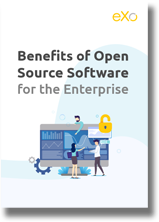- Fares Laroui
- December 16, 2020
Everything you need to know about the future of open source
Wikipedia, Firefox and Linux are just a few examples of open source software that we have been using for years, whether that’s within our personal lives or working lives.
Though met with growing scepticism in the early years, open source solutions (OSS) grew in popularity thanks to their ability to drive innovation through connected communities, find and deliver solutions for various challenges, and generally make information readily available for developers and of course end customers.

Content
OSS have been successful in attracting the interest of both the general public as well as businesses and tech giants, who have become more open to sharing their source codes (e.g. Alibaba); these organizations have recently engaged in a widely publicized and expensive shopping spree of open source software.
Think of Microsoft’s deal to acquire GitHub for a reported $7.5 billion in stock or IBM’s deal to purchase RedHat for a staggering $34 billion back in 2019. These deals marked a new era for open source software, with many companies willingly leaning towards open source to build and deliver their solutions.
In this blog post, we will first discover how open source led the fight against the recent Covid-19 pandemic and later examine the future of open source as a whole.
Open source during Covid-19
In a blog post I wrote right at the start of the pandemic, back in March, I asked the question, “Will Covid-19 start a remote working revolution?” The short answer is yes. In the last couple of months we have seen businesses of all sizes and industries shift and adapt their operations towards more transparent and flexible working arrangements.
“History tells us that the IT industry responds to economic disruption in both short-term (cost-cutting) and long-term (technology adoption shifts) ways. There is no reason to believe this disruption will not follow suit, and we can expect the industry to come out of this event different than it was in January 2020,” said Al Gillen, GVP, Software Development and Open Source, IDC.
One key and common factor that contributed to the timely and smooth implementation of such policies was the wide availability of open source solutions that enable even businesses with limited IT budgets to gain access to cutting-edge technologies to facilitate knowledge sharing, foster collaboration and maintain their operations overall.
Open source digital workplace solutions, video-conferencing platforms and chat applications – among a host of other enterprise software – have witnessed a surge in demand, especially in the first months of lockdown.
Zoom – an open source video-conferencing platform – became the most downloaded app on the iStore, while Jitsi – another video-conferencing provider – has, to date, reached 20 million monthly users.
The role of open source isn’t limited to facilitating remote working though. Many open source projects have actively led the fight against Covid-19 by connecting healthcare practitioners and researchers around the globe and making information easily accessible to the general public through dedicated portals.
For example, the global shortage of ventilators worldwide led many parties from manufacturers, universities and non-profits to come together and build open source ventilators based on existing hardware and open source software.
This, in turn, led to quick response times and gradually satisfied demand in severely hit regions such as Italy during the first lockdown.
SORMAS (The Surveillance Outbreak Response Management and Analysis System) is another example of the power of open source datasets and communities.
Created primarily during the Ebola outbreak in West Africa, SORMAS is an open source mobile platform that aims to prevent and control diseases and identify potential outbreaks in countries with limited resources.
As of today, it has been successfully used by healthcare specialists in Ghana and Nigeria covering a population of up to 85 million people.
And last but not least, the open source approach has been used to some extent to develop a vaccine by certain pharmaceutical companies.
Obviously, many have opted to more or less limit collaboration in order to win the vaccine race, with the majority relying on existing datasets during the initial phases to gather a thorough understanding of the disease and identify vaccine targets.
But this open source approach isn’t by any means new. It has been successfully adopted by the Open Source Drug Discovery (OSDD) project and The Synaptic Leap’s Schistosomiasis (TSLS) project to develop drugs and vaccines for many other diseases.

FREE WHITE PAPER
Benefits of Open Source Software
for the Enterprise
for the Enterprise
Open source
en entreprise
The term open source refers to any solution that has its source code widely accessible to the public for modification and sharing.

FREE WHITE PAPER
Benefits of Open Source Software
for the Enterprise
for the Enterprise
The term open source refers to any solution that has its source code widely accessible to the public for modification and sharing.
Open source future trends
Examining the recent history of open source and the deep impact it had during the pandemic, we can safely deduce that open source is the way forward for companies from both ends of the spectrum (tech providers and tech buyers, contributors and users). In this section we will walk through some of the predictions on the future of open source.
The future of remote working is open source
As mentioned earlier, the Covid-19 pandemic will have undoubtedly changed the way we work for years to come.
Remote working will be embraced by more and more companies, leading to an increase in demand for enterprise software.
And when we talk about software, we have to talk about open source. Sure, some companies out there would choose proprietary solutions, but the significant financial hit post Covid will lead many to choose open source.
But the choice to opt for open source won’t be based on the absence of licensing fees alone.
Extensibility, interoperability and allowing IT teams to have greater control over security IT audits, among other benefits, would most certainly guarantee the high and wide adoption of open source software for remote teams.
More advancements in open source AI
Probably any internet article concerning the future of virtually anything technology related contains the magic two letters AI.
Artificial intelligence and machine learning have gained increased interest in the last decade or so. With the field still relatively in its infancy, the focus for many AI start-ups and initiatives is on innovation and the exchange of knowledge.
As is the case with any open source project, everything revolves around driving innovation through dedicated communities where contributors share code at the algorithm level, allowing other parties to first understand specific patterns and later reuse and integrate the code within their own solutions.
Examples of industries engaged in open source projects include the automobile industry with its self-driving cars and the banking & finance sector with AI solutions aiming at analyzing large sets of data and the list goes on.
A cloudy future
A few years back, the relationship between open source and cloud vendors was a bit complicated to say the least.
Many open source businesses were weary that large cloud vendors would simply take their open source code, repackage it and sell it at a much higher price, posing a threat to their communities.
However, recently, certain open source vendors such as MongoDB and DataStax have been moving towards the cloud and gradually transitioning from their on-premise heritage.
This move also helped to facilitate the use of open source software, especially large databases which require experts to constantly run and maintain them. In the short and long term, we expect many other solutions to follow suit.
FOG computing will certainly be something big
To quote Wikipedia: “Fog computing or fog networking, also known as fogging, is an architecture that uses edge devices to carry out a substantial amount of computation, storage, and communication locally and routed over the internet backbone”.
Let’s break down this definition and make it a bit simpler. In its basic form, think of fog computing as an extension of the cloud (or something in between the devices we use and the clouds in the sky, hence the name I guess).
It’s a distributed network (as opposed to cloud computing, which is a centralized system) that connects multiple components such as edge devices (which are devices such as IoT sensors that connect a local network to an external one).
As of today, there are multiple open source solutions that power fog computing for a variety of projects that mainly revolve around IoT, such as smart cities, smart home security systems, wearables, and so on.
eXo Platform 6 Free Datasheet
Download the eXo Platform 6 Datasheet and
discover all the features and benefits
discover all the features and benefits
5/5 - (13 votes)
I am a product marketing specialist at eXo. My role is to assist marketing and sales teams in their operations and present our digital workplace solution to the world. I mainly blog about the latest tech trends, digital transformation, internal communication and how to navigate through eXo Platform.
Related posts
- All
- eXo
- Digital workplace
- Employee engagement
- Open source
- Future of work
- Internal communication
- Collaboration
- News
- intranet
- workplace
- Knowledge management
- Employee experience
- Employee productivity
- onboarding
- Employee recognition
- Change management
- Cartoon
- Digital transformation
- Infographic
- Remote work
- Industry trends
- Product News
- Thought leadership
- Tips & Tricks
- Tutorial
- Uncategorized
Leave a Reply
( Your e-mail address will not be published)
Connexion
0 Comments
Commentaires en ligne
Afficher tous les commentaires


